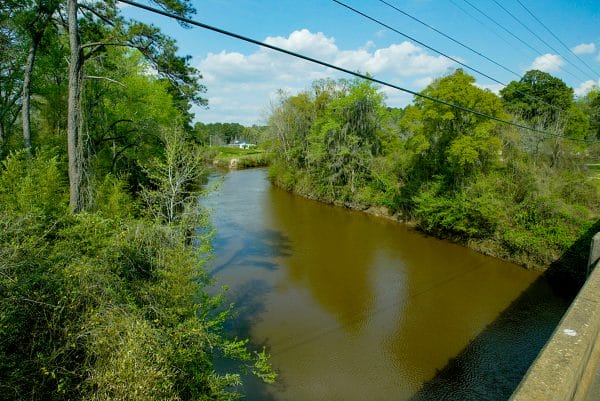Battles of Hobdy’s Bridge and Pea River
The 1837 Battles of Hobdy’s Bridge and Pea River took place east of present-day Banks, Pike County, and west of Louisville, Barbour County, and were part of an increase in hostilities between the U.S. government and the remaining members of the Creek Nation who wish to relocate to Florida, near the Seminole, rather than move west. They are largely considered to be the end of major skirmishes between the Creek Nation in Alabama and various American forces during the Second Creek War (1836-37). By the war’s end, U.S. troops and militia from Alabama and Georgia had violently forced all indigenous people from the region.
Following the Creek War of 1813-14, a series of treaties laid the foundation for relations between the Creek Nation and the United States in Alabama. The Treaty of Fort Jackson (1814) ceded almost 22 million acres of tribal land to the United States. The Treaty of Cusseta (1832) took control of all remaining Creek land east of the Mississippi River, including a large section of some five million acres in east central Alabama. That treaty reserved more than two million acres for the Creeks but essentially urged most remaining Creeks to leave the region. By the mid-1830s, large numbers of white settlers had moved into Alabama and illegally squatted on Creek land, and land speculators had swindled many Creeks out of their land. These incidents created tensions with members of the Creek Nation who had not migrated west or to Florida that reached a boiling point by 1836.
Many of these remaining Creeks resisted orders to migrate west to planned reservations in favor of moving further south to Florida, where they believed they would find safety and new homelands among existing Seminole villages. Over multiple years of migration, the Creeks followed a route that took them along the Pea River, where temporary camps near Hobdy’s Bridge drew the attention of U.S. forces intent on driving them out of the region. On February 10, 1837, between Banks and Louisville, Capt. Jack Cooper and 100 American militiamen engaged an estimated 75 Creek migrants as they camped near Hobdy’s Bridge. Cooper divided his men into two groups and launched a surprise attack on the unsuspecting Creeks. Though armed with little ammunition and few supplies, Cooper’s attack proved successful for the United States. An estimated five Creeks and one American were killed in the battle, after which the surviving Creeks fled to the Florida border. There, they allegedly killed two white settlers in retaliation for the attack.
A few weeks later, on March 27th, the Battle of Pea River took place not far from the Hobdy’s Bridge site. Gen. William Wellborn and his troops, numbering 250 Alabama and Georgia militiamen, followed a path of burned plantations left by the Creeks as they moved south. Wellborn eventually tracked around 400 Creeks to a camp near the Pea River and then divided the troops with Col. Jefferson Burford. They planned a surprise attack on two fronts, but unbeknownst to them, the Creeks had already discovered their presence and launched a surprise pre-emptive attack on Buford’s men, causing them to scatter. When Wellborn reached the site, an estimated four-hour battle ensued. Many observers recalled the event as a massacre of the Creek people, with an estimated 50 men, women, and children killed as well as five or so Americans. The Creek survivors split into smaller groups and continued their move south. Following these battles, the last events of the Second Creek War took place along the border and into Florida. In commemoration of the lives lost during the Battle of Hobdy’s Bridge, the Lower Creek Muscogee Tribe erected a historic marker just east of the Pea River on Alabama Route 130 in conjunction with the Alabama Historical Association in 2008. Historic markers remembering the Battle of Pea River and the Second Creek War also stand today in Louisville.
Further Reading
- Ellisor, John T. The Second Creek War: Interethnic Conflict and Collusion on a Collapsing Frontier. Lincoln: University of Nebraska Press, 2010.
- Lewis, Herbert James. Lost Capitals of Alabama. Charleston: The History Press, 2014.







